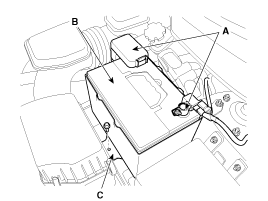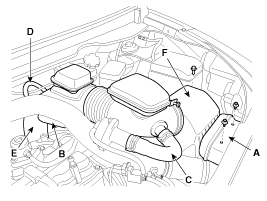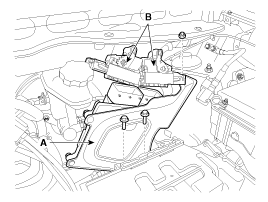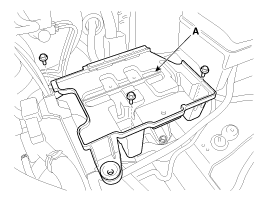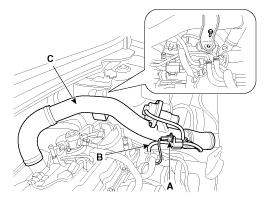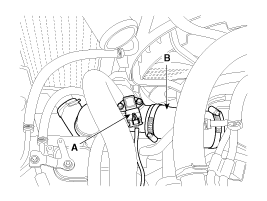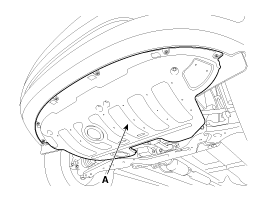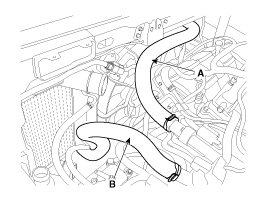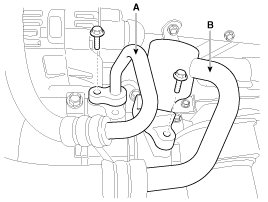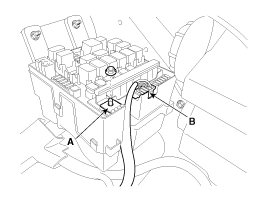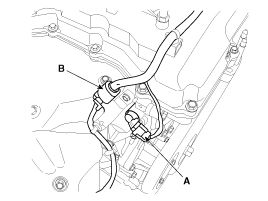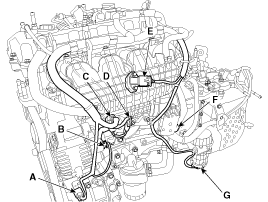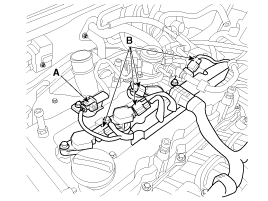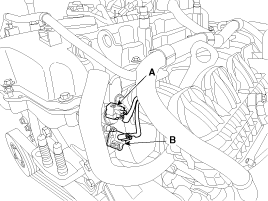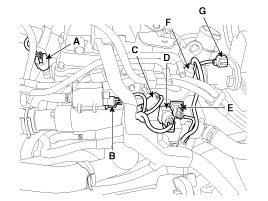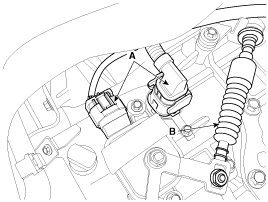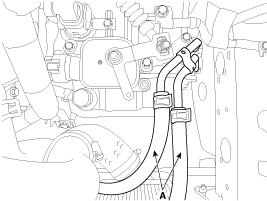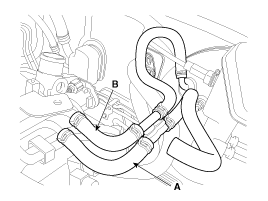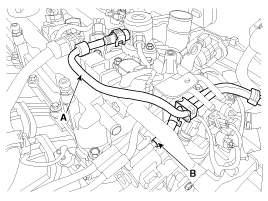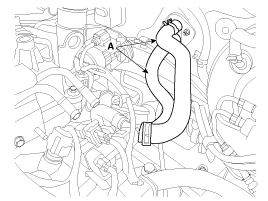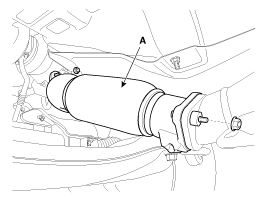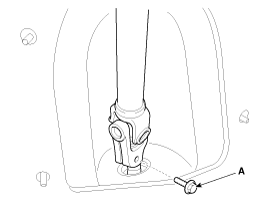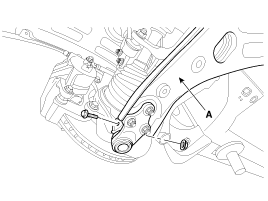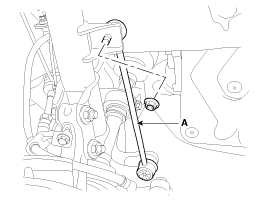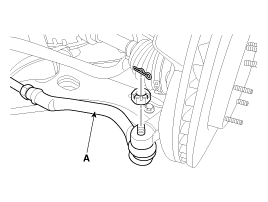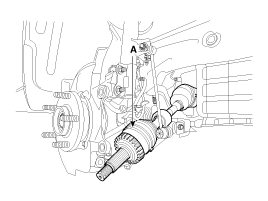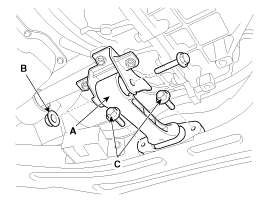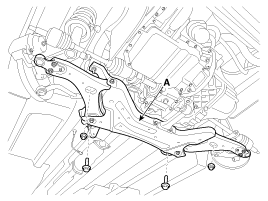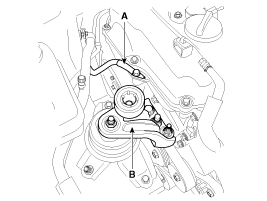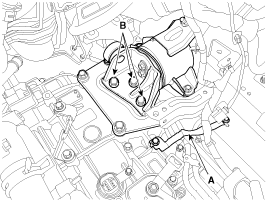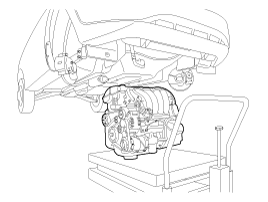 Kia Sportage: Engine And Transaxle Assembly: Repair procedures
Kia Sportage: Engine And Transaxle Assembly: Repair procedures
Third generation SL (2010Ц2016) / Kia Sportage SL Service & Repair Manual / Engine Mechanical System / Engine And Transaxle Assembly / Engine And Transaxle Assembly: Repair procedures
| Removal |
|
|
| 1. |
Remove the engine cover. |
| 2. |
Disconnect the battery terminals (A).
|
| 3. |
Remove the battery (B) after removing the mounting bracket (C).
|
| 4. |
Remove the air cleaner assembly.
|
| 5. |
Remove the ECM (A) after disconnecting the connectors (B). (Refer to FL group)
|
| 6. |
Remove the battery tray (A).
|
| 7. |
Disconnect the recirculation valve connector (A) and the
vacuum hose (B), and then remove the intercooner inlet pipe & hose
assembly (C).
|
| 8. |
Disconnect the boost pressure sensor connector (A) and then remove the intercooler outlet pipe & hose assembly (B).
|
| 9. |
Remove the under cover (A).
|
| 10. |
Loosen the drain plug, and drain the engine coolant. Remove
the radiator cap to drain with speed. (Refer to Cooling system in this
group) |
| 11. |
Disconnect the radiator upper hose (A) and lower hose (B).
|
| 12. |
Recover the refrigerant and then remove the high pressure
pipe (A) and low pressure pipe (B). (Refer to Air conditioning system in
HA Group.)
|
| 13. |
Disconnect the (+) cable (A) and connector (B) from the fuse/relay box.
|
| 14. |
Disconnect the wiring connectors and harness clamps, and
remove the wiring protectors from the cylinder head, intake manifold and
exhaust manifold.
|
| 15. |
Remove the transaxle wire harness connectors (A) and control cable (B) from the transaxle. (Refer to AT group).
|
| 16. |
Disconnect the ATF cooler hoses (A).
|
| 17. |
Disconnect the intensifier hose (A) and the vacuum hose (B).
|
| 18. |
Disconnect the fuel hose (A) and PCSV (Purge control solenoid valve) hose (B).
|
| 19. |
Disconnect the heater hoses (A).
|
| 20. |
Remove the front muffler (A).
|
| 21. |
Remove the steering u-joint mounting bolt (A). (Refer to ST group)
|
| 22. |
Remove the front wheels. |
| 23. |
Remove the lower arms (A). (Refer to SS group)
|
| 24. |
Remove the stabilizer bar links (A). (Refer to SS group)
|
| 25. |
Remove the tie rod ends (A). (Refer to ST group)
|
| 26. |
Disconnect the drive shafts (A) from the axle hubs. (Refer to DS group)
|
| 27. |
Remove the roll rod bracket (A).
|
| 28. |
Support the sub frame (A) with a floor jack, and then remove the sub frame mounting bolts and nuts.
|
| 29. |
Disconnect the ground line (A), and then remove the engine mounting support bracket (B).
|
| 30. |
Disconnect the ground line (A), and then remove the transaxle mounting support bracket (B).
|
| 31. |
Remove the engine and transaxle assembly by lifting vehicle.
|
| Installation |
Installation is in the reverse order of removal.
Perform the following :
| Х |
Adjust a shift cable. |
| Х |
Refill engine with engine oil. |
| Х |
Refill a transaxle with fluid. |
| Х |
Refill a radiator and a reservoir tank with engine coolant. |
| Х |
Clean battery posts and cable terminals and assemble. |
| Х |
Inspect for fuel leakage. |
| Ц |
After assemble the fuel line, turn on the ignition switch (do
not operate the starter) so that the fuel pump runs for approximately
two seconds and fuel line pressurizes. |
| Ц |
Repeat this operation two or three times, then check for fuel leakage at any point in the fuel line. |
| Х |
Bleed air from the cooling system. |
| Ц |
Start engine and let it run until it warms up. (until the radiator fan operates 3 or 4 times.) |
| Ц |
Turn Off the engine. Check the level in the radiator, add
coolant if needed. This will allow trapped air to be removed from the
cooling system. |
| Ц |
Put radiator cap on tightly, then run the engine again and check for leaks. |
 Engine Mounting: Components and Components Location
Engine Mounting: Components and Components Location
Components
1. Transaxle mounting bracket 2. Roll rod bracket3. Sub frame 4. Engine mounting bracket5. Engine mounting support bracket
...
 Timing System
Timing System
...
Other Information:
Luggage Room Lamp: Repair procedures
Removal
1.
Disconnect the negative (-) battery terminal.
2.
Remove the luggage room lamp (B) when prying the hole (A) with a flat-up screwdriver.
3.
Remove the luggage room lamp bulb in ca ...
Transaxle Control Module (TCM): Description and Operation
Description
Transaxle Control Module (TCM) is the automatic
transmission''s brain. The module receives and processes signals from
various sensors and implements a wide range of transmission con ...
Categories
- Home
- Kia Sportage QL (2015-2019) Owners Manual
- Kia Sportage QL (2015-2019) Service Manual
- Kia Sportage SL 2010-2016 Owners Manual
- Kia Sportage SL 2010-2016 Service Manual
Copyright © www.kispmanual.com 2014-2025



